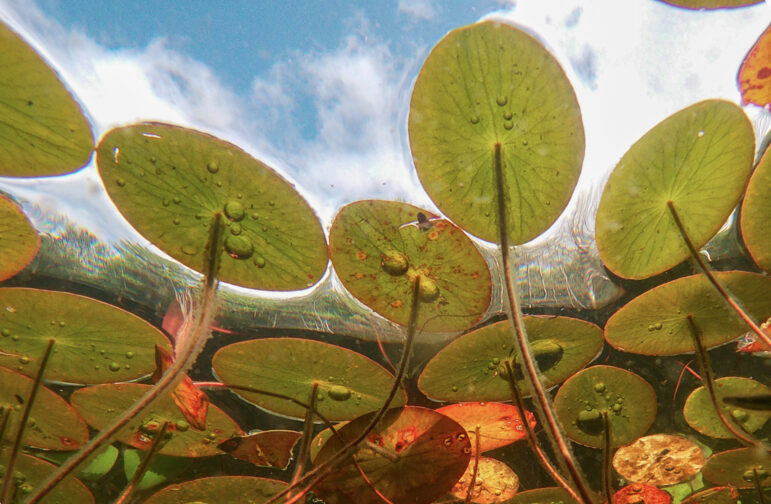
Jeremy Hartsock
Vegetation in Shupac Lake, near Grayling, marks the transition between a wetland and the open water. Wetlands are crucial to clean waterBy KELSEY LESTER
Capital News Service
LANSING — Early European settlers deemed Michigan’s wetlands a “dangerous wasteland.”
Little did they know the state’s wetlands were keeping their new home healthy.
Often recognized as “Earth’s kidneys” because of their long-term ability to filter pollutants, Michigan’s wetlands have a huge impact on the land.
Wetlands cover about 15% of the state, while 40% of all plant and animal species live and breed in them, according to the U.S. Fish and Wildlife Service. The ecosystems are large carbon sinks, contributing to the removal of carbon in the atmosphere — which has a lot to do with climate resiliency.
Wetland ecologist Jeremy Hartsock at Michigan State University joked that if he could, he’d turn all of Michigan into wetlands — or at least where they’re supposed to be.
According to the Ecological Society of America, wetlands mitigate climate change and natural disasters. Storing and consistently releasing water downstream, they can help with soil infiltration to lessen floods in extreme weather. They also can buffer wave energy to reduce the impact of coastal storms.
Because of their ability to store carbon, when wetlands are degraded or aren’t managed properly and decompose, the carbon is released back into the atmosphere. Hartsock said that exacerbates climate change.
“It would be a real shame,” Hartsock said. “What a terrible loss and you know, so much of it is preventable.”
As a no-wetland loss state, anyone who wishes to alter a wetland legally must alleviate that loss by restoring the wetland.
One common technique is to have wetland banking sites. In that approach, those who wish to alter wetlands — usually corporations — pay for already restored projects.
Many such projects are on former farmlands that used to be wetlands.
For such projects, agencies do meticulous research into the historical geography of the farmland to re-convert it into a wetland, Hartsock said.
“It’s a much better way to make sure better wetlands are being put on the landscape rather than the older way of doing mitigation,” he said. “Old-way” mitigation wetlands were small.”
“They were dinky and didn’t provide any functions, but now they’re these big mitigation bank sites that are big crater wetlands.”
The state this year has allocated $13 million for wetland restoration, including $550,000 for urban projects.
“It is something that benefits everybody, and I think it really is a good use of tax dollars — those things that really improve the environment for everybody,” said Michael Van Loan, who works as a Department of Environment, Great Lakes and Energy Voluntary Wetland Restoration project coordinator.
The funding comes at a convenient time with the recent detection of hydrilla, one of the world’s most invasive aquatic plants, in Berrien Springs.
Randy Knapik, a Department of Natural Resources wetland habitat biologist, said invasives are always a concern.
“With the amount of funding being allocated for wetland restoration here in the Great Lakes states, we are in a very critical moment,” he said.
Donna Cervelli, a floodplain engineer for Environment, Great Lakes and Energy, added that wetlands give the state many recreational and tourism opportunities.
“Some wetlands are on state land or some of the national refuge areas. So those are known to be big birding habitats. So they’re used by birders and hunting and all types of recreational purposes,” she said.
“We should feel thankful that Michigan has wetland protection programs,” Cervelli said. “These programs are not common across the country — for states to have their own programs a lot of them are run federally.”
Knapik said he is hopeful for the future of the state’s wetlands.
“It’s a very exciting time to be in the preservation and wetland restoration side of things here in Michigan, with the heightened awareness of the positive impact that wetlands and wetland restoration can have,” Knapik said.

Jeremy Hartsock
A turtle enjoys the wetland ecosystem. Multiple efforts are underway in Michigan to avoid the loss of wetlands